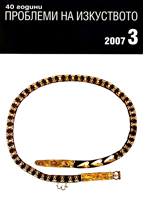За една сцена върху Охридските врати и нейното значение за зооморфната образност през Средновековието
On One Scene from the Ohrid Doors and Its Significance for Zoomorphic Imagery During the Middle Ages
Author(s): Daniel FokasSubject(s): Cultural history
Published by: Институт за изследване на изкуствата, Българска академия на науките
Summary/Abstract: This article examines problems related to one of the scenes depicted on the so-called “Ohrid Doors” or the doors of the Church of St. Nicholas Bolnichki in Ohrid. It is one of the scenes included in the doors’ conceptual program that has not yet been identified and interpreted. Two possible interpretations have been suggested. The first connects the scene with illustrations from the life of the Prophet Jonah (Jonah 1:15 - 2:1) (M. Chorovic-Lyubinkovic and D. Drumev), while according to the second, the composition is related to the signs of the zodiac and the calendar (A. Grabar). However, closer analysis has established that such interpretations of the scene are not sufficiently convincing. A comparison of the scene with passages from the book of Genesis has given rise to the considerably more plausible the- sis that the image represents the scene of “Adam Naming the Animals.” In our opinion, it was influenced by the allegorical interpretation offered in the works of church writers (such as Origen; Theodorit of Cyr; St. Ambrose, Bishop of Milan; Narsai of Edes) about Adam and his power over the animals. The image not only represents the scene “Adam Naming the Animals,” but also shows us Adam in his glory as the master of the Earthly Paradise created by God. It is closely related to the more ancient Yahvist version of creation reflected in the book of Genesis (Gen. 1:26), as well as in one verse from the Psalter (Ps. 8:7-9), finding its closest parallel in scenes in mosaics from fifth- century Syria (Huarte, Hama and Copenhagen) and Greek and Latin psalters from the 8th through the 13th centuries. The scene and the symbolism found therein played a major role in legitimizing zoomorphic images in Christian art. It positions creatures with respect to man and the world in a symbolic way. Its symbolism expresses Adam’s status as the master of all creation, who gave names (qualities) to the animals. This made it possible for zoomorphic motives to exist in medieval Christian art as independent units of meaning, appearing as the personification of just such spiritual qualities and states.
Journal: Проблеми на изкуството
- Issue Year: 2007
- Issue No: 3
- Page Range: 38-44
- Page Count: 7
- Content File-PDF

